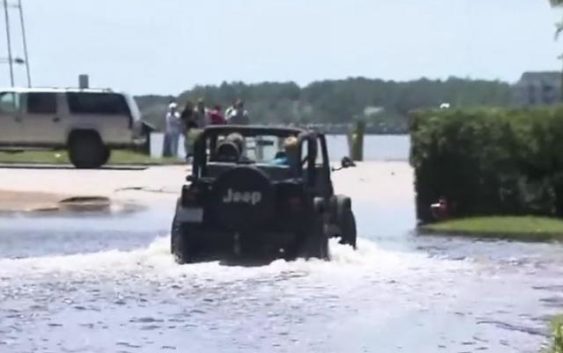- Austin leaders consider expanding wildfire protection plan
- Large hail, strong winds and tornado threat possible into Thursday evening
- Large hail, tornado threat possible Thursday evening
- Jaccob Slavin scores in OT as the Hurricanes beat the Capitals in Game 1 of their 2nd-round series
- 5 On Your Side: What happened to cars flooded during Hurricane Helene?
NC cities get 'dry run' in preparing for hurricane during a pandemic

Hurricane Season doesn’t typically kick into high gear until September. August 3 and 4 is very early for a hurricane to hit North Carolina – meaning our Hurricane Season has likely just barely begun.
For many North Carolina communities who were not as heavily impacted by Hurricane Isaias, the storm provided an opportunity to practice a “dry run” on how to prepare for a hurricane during the pandemic.
While some communities did experience tragic loss of life and property from tornadoes and explosions, many counties are breathing a sigh of relief – and trying to learn from the experience.
How to prepare hurricane shelters during COVID-19
Gene Booth, the Emergency Services Director for Cumberland County, said Isaias provided a good dry run to test how to operate in a hurricane during a pandemic.
Although Cumberland County didn’t have to open any shelters during the storm, they were able to do a practice run, which allowed them to stockpile supplies to prepare for September or October when larger hurricanes could come through. They also put into place operations on how to most safely open a shelter while also contending with COVID-19.
How to prepare for flooding during the pandemic
As the sun came out Tuesday and the waters began receding, many communities also breathed a sigh of relief that Hurricane Isaias did not bring immense damage to their areas.
The fire chief for Nag’s Head said they anticipated water on the roads and were prepared ahead of time.
In Manteo, some downtown roads were flooded, and some homes by the side of the sound had water rushing up very close to their yards. Police blocked off the flooded roads, and the water seems to be receding quickly. Sir Walter Raleigh Street was covered with water, but within a matter of hours it was dry.
In the aftermath of Isaias, children played in the flooded streets, sliding on body boards and riding bicycles through the water, while families stood on raised decks, watching the flood waters recede.
Hatteras Island will open at 2 p.m., but officials warn drivers to be careful on Highway 12, where not all the water has receded.
Goldsboro officials also noted that, although they have several creeks and parks that are notorious for flooding during hurricanes, they did not have a substantial impact from flooding.
Like many communities, Goldsboro saw heavy rain, wind gusts of around 50 mph, a few downed trees and some power outages. Nash, Edgecombe and Wilson counties have also seen devastating impacts in the past, but faired well this time.
One homeowner whose house is within the typical flood zone for Locke’s Creek in Fayetteville was relieved that the flooding wasn’t as intense as with previous storms.
The area around the creek has been built up to help prevent the water from rising. However, Isaias only dropped a few inches of rain on Cumberland County. A hurricane like Matthew or Florence could drop 10 inches or more, bringing more intense flooding.
The real question: What do we do when a real big storm comes? The hurricane season is still young, but a ‘smaller’ storm like Isaias provided a chance to learn how to operate in a pandemic, without also having to content with a real statewide disaster – this time.
How to prepare for power outages during a pandemic
Currently, more than 4,000 are without power in Carteret and Craven County.
Power crews in Emerald Isle were staged ahead of time, knowing the community would be hard hit.
A power pole on Emerald Drive split in half. There have been crews out there for several hours; however, the heavy wind and gusts prevented them from going up in bucket trucks to get a closer look until the past hour or so.
Power should be restored around 2 or 3 p.m., according to the Electric Cooperative. However, some people could have to wait until 11 p.m. or later tonight until they are fully back up and running.
Despite all the outages, the impact from Isaias was still less than previous, larger hurricanes. Some locals were quoted calling Isaias “a baby hurricane,” when explaining why they were not evacuating.
While Hurricane Isaias was damaging – bringing floods, downed trees, power outages and even loss of life – it certainly could have been much worse, when compared with some of the more powerful storms that have hit NC through the years.
North Carolinians know how to manage themselves in a hurricane, but adding a pandemic to the mix meant certain long-standing operations and procedures would have to change. Hurricane Isaias may have just helped emergency crews become better prepared for whatever storms may impact NC later this year.